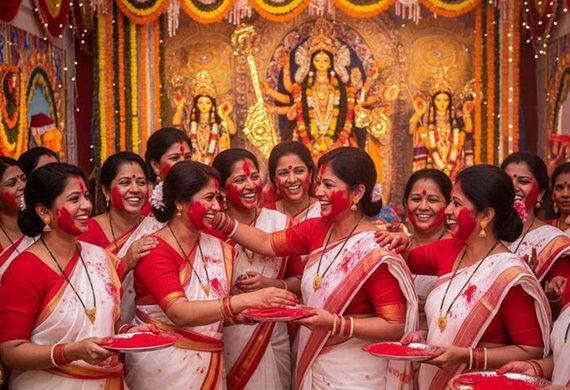
Women Perform Sindur Khela Marking End of Durga Puja Across India
By: WE Staff | Friday, 3 October 2025
- Married Bengali women smear Vermilion to bid farewell to Maa Durga & wish prosperity
- Thousands in red and white sarees turn pandals into seas of color & joy on Vijayadashami
- Mumbai adds music & causes, Agartala stays rooted, urban hubs like Delhi & Bengaluru rediscover heritage
As the final chants of Durga Puja filled pandals across the country on Thursday, October 2, 2025, women in red-bordered white sarees gathered with plates of vermilion to perform a ritual as old as memory, Sindur Khela, making the culmination filled with devotion, color, and evolving meanings. Traditionally, a ritual in which married Bengali Hindu women smear vermilion on each other to wish for prosperity and marital bliss, Sindur Khela has evolved into a broader celebration of feminine power, solidarity, and cultural continuity.
In Kolkata, the epicenter of Durga Puja, thousands of women draped in red and white sarees turned the ritual into a breathtaking spectacle of devotion and festivity. The traditional 'Baran' ritual, bidding farewell to Goddess Durga, was followed by laughter, music, and an explosion of vermilion across temple courtyards and pandals.
Beyond Bengal, the ritual carried diverse expressions. In Mumbai, Bengali cultural associations gave Sindur Khela a cosmopolitan twist, blending it with dance, music, and social causes. In Agartala and other parts of the Northeast, temple-centered celebrations upheld deeply rooted traditions, while in Delhi, Pune, Bengaluru, and other urban hubs, younger generations embraced the ritual as a way to reconnect with heritage.
What was once limited to married women has also seen contemporary shifts with widows, unmarried women, and even members of the LGBTQ+ community joining in some regions, reflecting a growing inclusivity in interpretation.
Scenes of joy echoed nationwide as women smeared each other with vermilion in New Delhi, Prayagraj, Patna, and Ajmer, each city adding its own cultural flavor to the ritual. In every location, the symbolism remained clear that Sindur Khela is not just a farewell to the goddess, but a reaffirmation of sisterhood and the goddess within every woman.
Most Viewed
- 1 Women's Health Startup HerMD Closing Doors Amid Industry Challenges
- 2 5 Famous Women in Indian Armed Forces
- 3 Saudi Women No longer Require Male Permission for Clothing Choices, says Prince MbS
- 4 Kolkata Medtech Startup Innovodigm Raises Rs 5.5 Crore Seed Funding Led by IAN Group
- 5 Yamunanagar's Kashish Kalra Honoured after Securing 111th Rank in UPSC Civil Services Exam
- 6 Madurai Appoints Its First Woman Corporation Head
- 7 IAS Vijayalakshmi Bidari Appointed as the new Nagpur Divisional Commissioner
- 8 American Entrepreneur Lucy Guo Overtakes T Swift to become Youngest Female Billionaire
- 9 ICC Women's World Cup 2025 Trophy Showcased at Indore's Holkar Stadium
- 10 Aparna Saxena's Beauty Venture AntiNorm Launches in India
- 11 Vidya Nataraj Co-Founded BlueStone Jewellery & Lifestyle files IPO
- 12 5 Women Freedom Fighters of India
- 13 Dr. G Krishnapriya appointed as CEO for Trichy
- 14 M3M & Sirona Partner to Introduce Menstrual Hygiene Vending Machines in 15 Locations
- 15 Punjab Govt launches SHE Cohort 3.0 Supporting Tech-led Women Startups
- 16 Indian origin Lawyer, Sweena Pannu appointed as the US New Superior Court Judge
- 17 The Aurora Tech Award recognizes 4 Indian Women-led Startups
- 18 Kerala's Republic Day parade featured an all-female tableau
- 19 Manisha Kabbur Becomes Karnataka's First Woman International Karate Coach
- 20 Director K. S. Ravikumar's Daughter Maalica Ravikumar Launches Life Coaching Company 'Evergrowth Academy' for Women
- 21 Leezu's Raises Pre-Seed Funding to Accelerate Growth in Sexual Wellness Industry
- 22 Sattu: Super-easy summer drink for PCOS gut healing
- 23 Swathi Nelabhatla creates Sitha App, India's First Women-Exclusive Gig Platform
- 24 7 Timeless Female Kathak Dancers & their Iconic Legacies
- 25 Meet 7 Iconic Women Architects of Modern India & their Most Impactful Work
- 26 This Woman-led Insuretech Startup is Helping Bridge the Education Financing Gap in India
- 27 Women Leaders Share Lessons Learnt from India Women's WC Win
- 28 5 Enterprising Women Founders Powering Singapore's Tech & Innovation Landscape
- 29 4 Women. 4 Stories. One Vision for Smarter, Stronger Healthcare
- 30 Global Gender Gap Narrows to 68.8%, But Full Equality 123 Years Away: WEF Report 2025
- 31 Changemakers: 7 Women Entrepreneurs Taking the Make in India Movement Forward
- 32 Meet Lucy Guo, The Youngest Self-Made Female Billionaire Disrupting Tech
- 33 How Women are Driving India's Festive Online Shopping Surge






